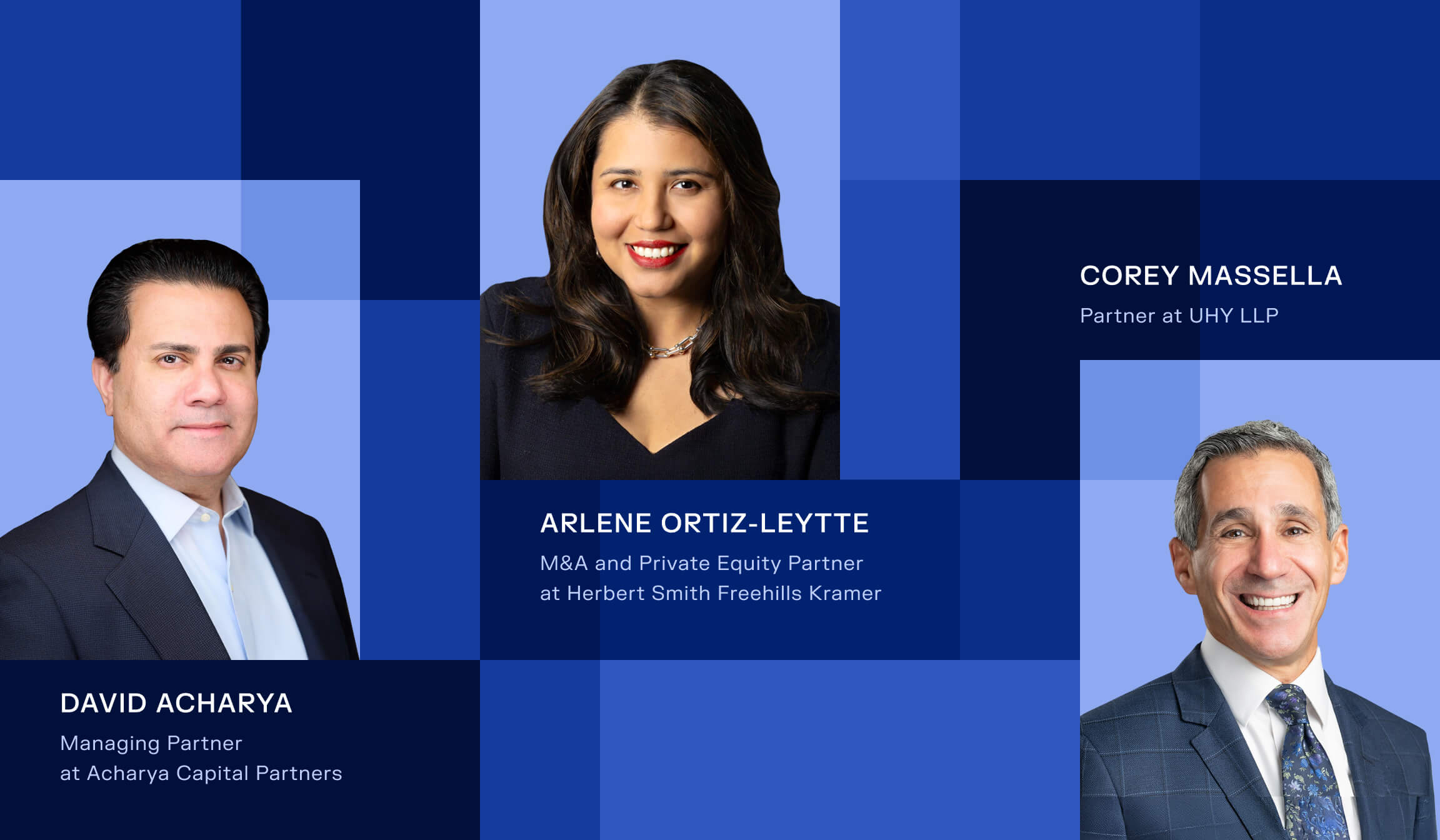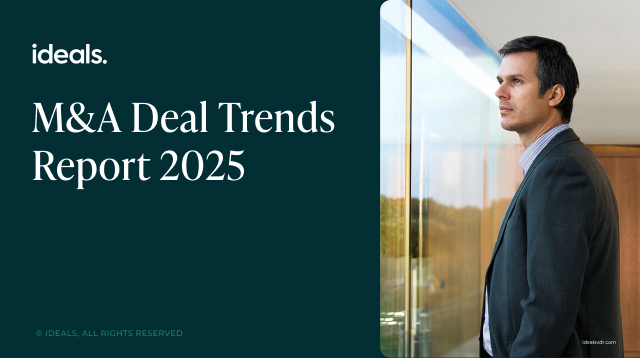US private equity firms are sitting on record levels of dry powder. Yet deploying that capital has become increasingly difficult in today’s volatile environment, shaped by global trade tensions, supply chain challenges, and macroeconomic uncertainty.
In our recent webinar — H2 private equity outlook: Navigate the downturn and drive recovery — three industry leaders shared how firms are adapting, highlighting evolving approaches to investment strategy, capital structure, and deal execution.
We were joined by:
- David Acharya, Managing Partner at Acharya Capital Partners
- Corey Massella, Partner at UHY LLP
- Arlene Ortiz-Leytte, M&A and PE Partner at Herbert Smith Freehills Kramer
This article covers the key trends that emerged during their conversation. Please contact the speakers directly if you’d like to discuss the topics in more detail.
01. Global uncertainty forces a localized approach
Rising tariffs and supply chain instability have prompted businesses to rethink international dependencies. Many US companies are reshoring production and prioritizing domestic assets that are less exposed to cross-border risk.
In response, private equity firms are reevaluating how they identify opportunities, placing greater emphasis on local investments within their portfolios.
David Acharya provided his perspective: “We’re not static investors. We shift into both protective and offensive modes.” He explained that general partners (GPs) started sourcing domestically during the pandemic, when global supply chains were disrupted. “That trend began during COVID-19 and has continued as firms adjust to tariff volatility.”
Acharya framed localization as part of a broader trend: “Globalization surged over the last 20 years, but political concerns, employment issues, and income distribution are fueling de-globalization. We may not reverse globalization entirely, but enthusiasm for it has waned.”
Globalization surged over the last 20 years, but local political concerns, employment issues, and income distribution are fueling de-globalization.
David Acharya, Managing Partner at Acharya Capital Partners
Corey Massella noted that executives are approaching dealmaking with increased caution, stating: “Many businesses are in pause mode. CEOs are being asked, ‘Who’s going to absorb the tariffs?’” This has led to delayed investments as companies adopt a wait-and-see approach.
Arlene Ortiz-Leytte observed a related shift toward industries with limited international exposure: “We’re seeing deals that rely less on imports and global supply chains,” she said. “That points to service-based sectors like healthcare, business and professional services, financial services, fintech, and insurance. Also, essential services like trash pickup and home repairs — things people need regardless of economic cycles.”
We’re seeing more deals relying less on imports and global supply chains
Arlene Ortiz-Leytte, M&A and PE Partner at Herbert Smith Freehills Kramer
02. Fundraising narrows to top players
Fundraising is growing more polarized, with top-performing mega-funds drawing most of the capital, while smaller and emerging managers face challenges.
With market uncertainty and more private debt options, institutional investors — such as pension funds and insurance companies — are taking a more selective approach. They’re diversifying, but favoring established firms with proven track records.
“This shift started 2–3 years ago as interest rates rose. Institutional investors began diverting capital from traditional private equity buyouts into private debt,” said Massella.
Facing tougher conditions, smaller and middle-market firms are relying on continuation funds to maintain liquidity. Acharya noted, “There are over 6,300 private equity firms in the US today, but not all deliver top-quartile returns. Some GPs are choosing to wind down rather than struggle to raise another fund.”
New capital sources are also emerging, with family offices and strategic buyers driving a larger percentage of deals. “Many deals are now strategic or family-office-led,” said Massella. “Not all transactions involve traditional private equity buyers. We’ve seen a recent surge in signed letters of intent (LOIs), with more in the past month than in the last three to four months combined.”
Many deals are now strategic or family-office-led. Not all transactions involve traditional private equity buyers.
Corey Massella, Partner at UHY LLP
03. Add-ons and carve-outs grow in popularity
Deal structures are evolving to balance risk and operational focus. “Classic platform deals are declining,” said Ortiz-Leytte. “Instead, take-private transactions and strategic add-ons are gaining popularity.” These deals often use sponsors’ existing liquidity or on-balance-sheet cash, allowing for faster execution and better operational alignment.
Take-private transactions and strategic add-ons are gaining popularity.
Arlene Ortiz-Leytte, M&A and PE Partner at Herbert Smith Freehills Kramer
Carve-outs — selling non-core assets — are being used to sharpen portfolio focus and support value creation. Ortiz-Leytte explained, “Carve-outs help realign the platform with its original investment thesis.”
Minority investments are also on the rise. “We’re seeing minority stakes executed via consortiums or continuation funds,” said Ortiz-Leytte. “These structures provide liquidity while allowing sponsors to retain exposure to promising assets, offering flexibility in an uncertain market.”
04. Buyers gain the upper hand
To bridge valuation gaps and align post-close performance, earn-outs, deferred payments, and rollover equity are all becoming more common.
Ortiz-Leytte noted a shift from 2021’s seller-friendly environment, which was characterized by fast deals and limited indemnities. “Buyers now demand detailed diligence and tailored indemnities, especially for risks outside representation and warranty insurance coverage.”
Pre-close diligence has intensified. Financials, tax compliance, and customer and supplier contracts face deeper reviews, and discrepancies between early-stage documents and final diligence can lead to renegotiation.
“If what you present in your CIM (confidential information memorandum) doesn’t match the data room, you open the door to re-trading,” Acharya warned. This means that early-stage legal and financial preparation — such as sell-side diligence, capitalization table reviews, and contract audits — is essential for successful deal execution.
A time for execution, not expansion
Private equity firms continue to demonstrate resilience in the face of ongoing challenges. Companies are shifting away from aggressive growth targets and high leverage to focus on operational improvements, innovative deal structures, and disciplined execution.
Many are doubling down on trusted relationships with management and capital partners, recognizing that collaboration and deal certainty are key in turbulent times. As Ortiz-Leytte put it: “Firms are adapting, using familiar tools in new ways and staying nimble.”





